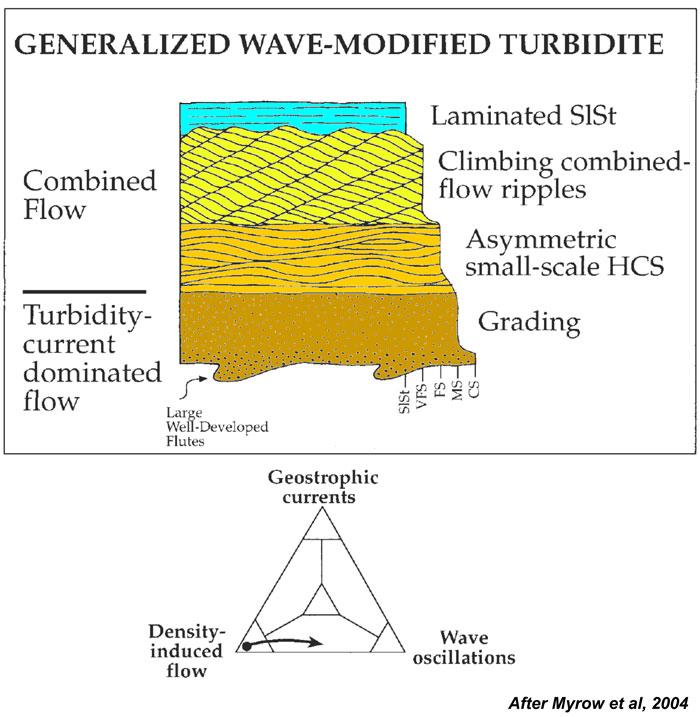|
bed
cycle
surfaces
tempestite
wave base
|
Sediment deposition and reworking associated with storms (tempestites) and turbidite currents (turbidites) are unpredictable, sudden, and catastrophic. Both experience many of the same processes, have similar character and so are difficult to distinguish from each other.
tempestites are the products of storms that produce waves and currents that extend to and just below wave base in shallow shelf settings. In contrast turbidites are the products of the suddent mobilization of sediment on the shelf margin by the sediment surface over-steepening on the sea floor and sudden movement downslope triggered potentially by too much sediment, storms and/or earthquakes.
Both tempestites and turbidites are the products of events that are "aperiodic" and of varying magnitudes, the larger the more rare. The larger events wipe out the signatures of earlier smaller ones. These dicyclic or non-periodic sequences are caused by irregular stratigraphic events, often the recurrent processes associated with the depositional regime (autocyclic processes) (Einsele et al , 1991). The sedimentary cycles of both tempestites and turbidites tend to be composed of graded bed s that fine upward, form symmetric or asymmetric cyclic bundles of sequences, as well as complete and incomplete cycles, the latter reflecting non-deposition and/or erosion during the depositional cycle. Recurring processes generate successions of bundles cyclic beds. Myrow in a series of publications, sometimes alone and sometimes with others (see below), has developed models that explain the hierarchy of expected sedimentary structures associated with tempestites and also considers how the surfaces of shallow turbidites are modified by waves.

The table and attached diagram below suggest strategies for separating tempestite deposits from those of turbidites.
|
|
tempestites |
turbidites |
|
Wave ripples and wave ripple cross lamination |
Common (apart from distal types) |
Absent |
|
Current ripples and current ripple bedding |
Less common than in turbidites |
Common |
| sedimentary structures |
Convolute lamination |
Rare |
Common |
(from top to bottom of bed)
|
Hummocky cross-stratification |
Common |
Absent |
|
Traction carpet with inverse grading |
Absent |
Common in proximal types |
|
Nature of sole marks |
Often bipolar, pronounced irregular scouring, gutter-casts channeling |
Uni-directional |
|
Benthic background community (in muddy intercalations) |
Shallow water fauna, differing with substrate consistency |
Deep-water fauna, mainly represented by burrows |
| Biofacies |
Displaced body fossils within event beds |
Shallow water species only |
Shallow and deep-water |
|
Autochthonous post-event fauna and bioturbation |
Fauna similar to pre-event fauna (return to background fauna, if substrate similar) |
Episodic colonization by specific fauna preceding return to background conditions |
|
Amalgamation |
Very common and pronounced including "maturation" of sediment |
Less common, no maturation effect |
| Stratigraphic context |
Continuity of single beds |
Mostly limited |
Often over wide distance |
|
Thickness of sequence |
Limited associated with shallow-water facies |
In general great, associated with deep-water facies |
Table (After Einsele et al, 1991)
References
Einsele G., Ricken W., and Seilacher A., (editors), 1991, "cycles and events in stratigraphy", Springer-Verlag, Berlin, Heidelberg, New York 1991. 955p.
Myrow, P.M. and Southard, J.B., 1991, Combined-flow model for vertical stratification sequences in shallow marine storm-dominated beds: Journal of Sedimentary Petrology, v. 61, p. 202-210.
Myrow, P.M., 1992, Bypass-zone tempestite facies model and proximality trends for an ancient muddy shoreline and shelf: Journal of Sedimentary Petrology, v. 62, p. 99-115.
Myrow, P.M., 1992, Pot and gutter casts from the Chapel Island formation, southeast Newfoundland: Journal of Sedimentary Petrology, v. 62, no. 4, p. 992-1007.
Myrow, P.M., 1994, Pot and gutter casts from the Chapel Island formation, southeast Newfoundland — reply: Journal of Sedimentary Petrology, v. A64, p. 706-709.
Myrow, P.M. and Southard, J.B., 1996, tempestite deposition: Journal of Sedimentary Research, v. 66, p. 875-887.
Myrow, P.M., Fischer, W., and Goodge, J.W., 2002, Wave-modified turbidites: combined-flow shoreline and shelf deposits, Cambrian, Central Transantarctic Mountains: Journal of Sedimentary Research, v. 72, p. 641-656.
|